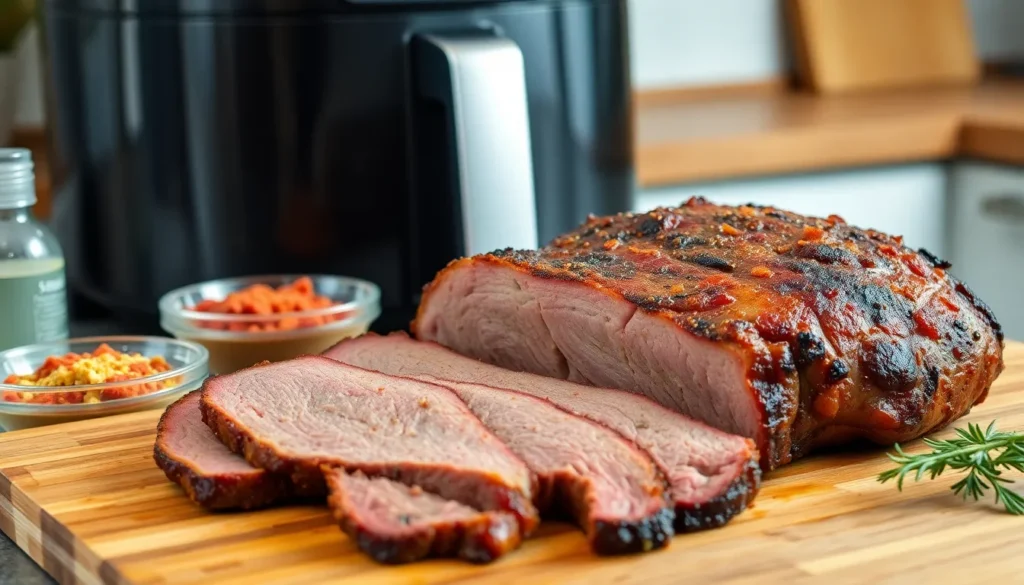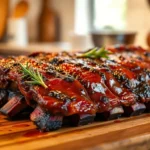We’ve revolutionized the way you can enjoy tender, smoky beef brisket without firing up the grill or waiting hours for your oven. Our air fryer beef brisket recipe delivers the same mouthwatering results you’d expect from traditional smoking methods – but in a fraction of the time.
This game-changing technique transforms your air fryer into a mini smokehouse that produces incredibly juicy brisket with a perfect caramelized crust. We’ve perfected the seasoning blend and cooking process to ensure every bite melts in your mouth while maintaining that signature brisket flavor profile.
Whether you’re craving comfort food on a weeknight or impressing guests without the lengthy prep time, this air fryer method will become your new go-to. We’ll walk you through every step to achieve restaurant-quality brisket that’s ready in under two hours – proving that exceptional flavor doesn’t always require exceptional time commitment.
Ingredients
Gathering the right ingredients sets the foundation for our exceptional air fryer beef brisket. We’ve carefully selected each component to maximize flavor while keeping the ingredient list simple and accessible.
For the Dry Rub
- 2 tablespoons paprika
- 1 tablespoon brown sugar
- 1 tablespoon kosher salt
- 1 teaspoon black pepper (freshly ground)
- 1 teaspoon garlic powder
- 1 teaspoon onion powder
- 1 teaspoon chili powder
- 1/2 teaspoon cumin
- 1/2 teaspoon smoked paprika
- 1/4 teaspoon cayenne pepper
For the Brisket
- 3-4 pound beef brisket flat (trimmed to 1/4 inch fat cap)
- 2 tablespoons olive oil
- 1/4 cup apple juice or beef broth (for spritzing)
Optional Sauce Ingredients
- 1/2 cup ketchup
- 2 tablespoons apple cider vinegar
- 2 tablespoons Worcestershire sauce
- 1 tablespoon brown sugar
- 1 teaspoon liquid smoke
- 1/2 teaspoon garlic powder
- Salt and pepper to taste
Equipment Needed
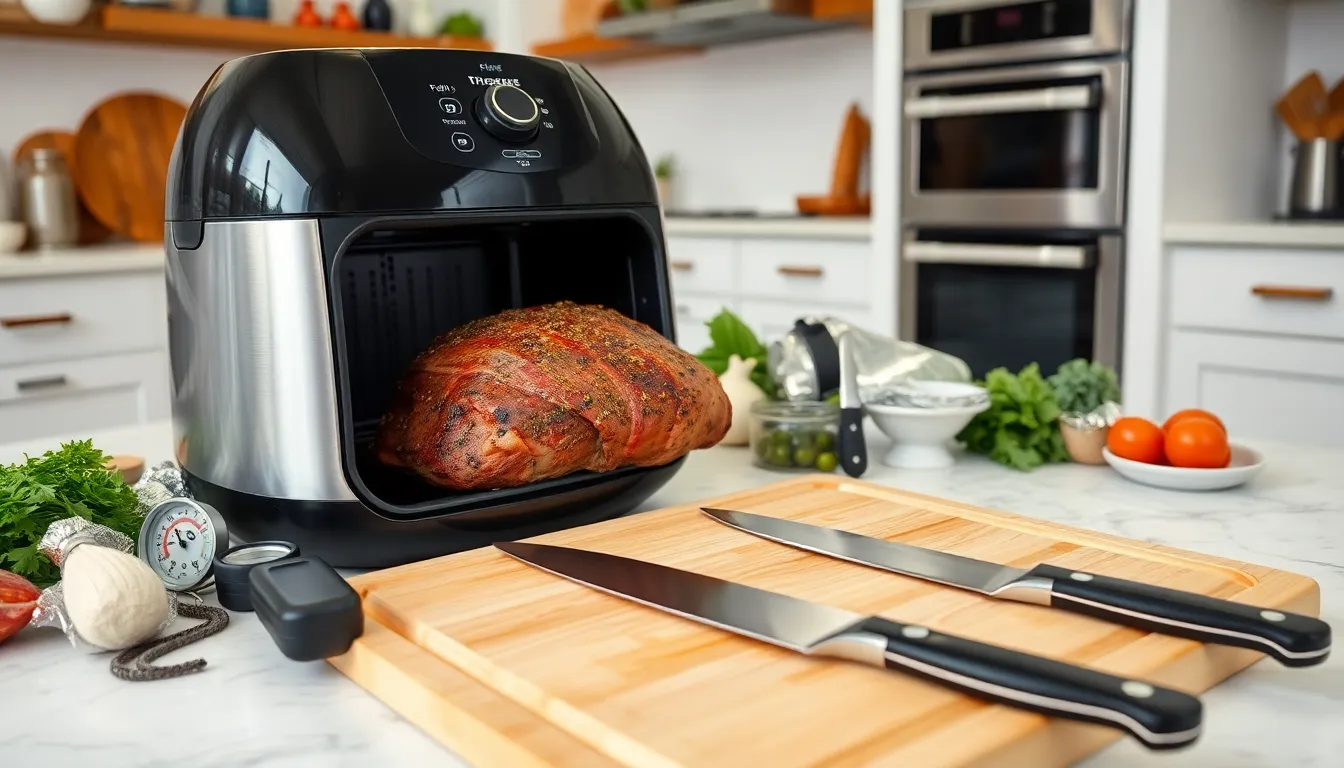
Creating the perfect air fryer beef brisket requires the right tools to ensure optimal results. We recommend using a standard countertop air fryer that accommodates your brisket size comfortably. For larger briskets weighing 3-4 pounds, consider using an air fryer toaster oven like the Emeril Lagasse Power Air Fryer 360 XL, which provides ample cooking space.
A reliable meat thermometer serves as our most crucial tool for achieving perfectly cooked brisket. We use this to monitor internal temperature and ensure our brisket reaches the ideal 185°F to 205°F range for maximum tenderness. Digital instant-read thermometers work best for quick and accurate readings.
Cooking spray becomes essential for preventing our seasoned brisket from sticking to the air fryer basket. We apply a light coating to the basket before placing our meat inside. This simple step saves us from frustrating cleanup and ensures easy removal.
Heavy-duty aluminum foil plays a vital role in our cooking process. We create foil boats to contain beef broth or apple juice during the cooking phase, which helps maintain moisture levels. The foil also protects our brisket from direct heat exposure during longer cooking periods.
A sharp carving knife allows us to trim excess fat before cooking and slice our finished brisket properly. We always slice against the grain to maximize tenderness. A large cutting board provides adequate workspace for both preparation and serving.
Our mixing bowl or large plate becomes the staging area for applying our dry rub seasoning blend. We use this space to ensure even coverage of all spices across the brisket surface. A spray bottle helps us apply our spritzing liquid evenly during the cooking process.
| Equipment | Purpose | Temperature Range |
|---|---|---|
| Air Fryer | Primary cooking vessel | 300°F-375°F |
| Meat Thermometer | Temperature monitoring | 185°F-205°F target |
| Aluminum Foil | Moisture retention | N/A |
| Sharp Knife | Trimming and slicing | N/A |
These essential tools work together to transform our air fryer into an efficient brisket-making machine that delivers restaurant-quality results every time.
Prep Instructions
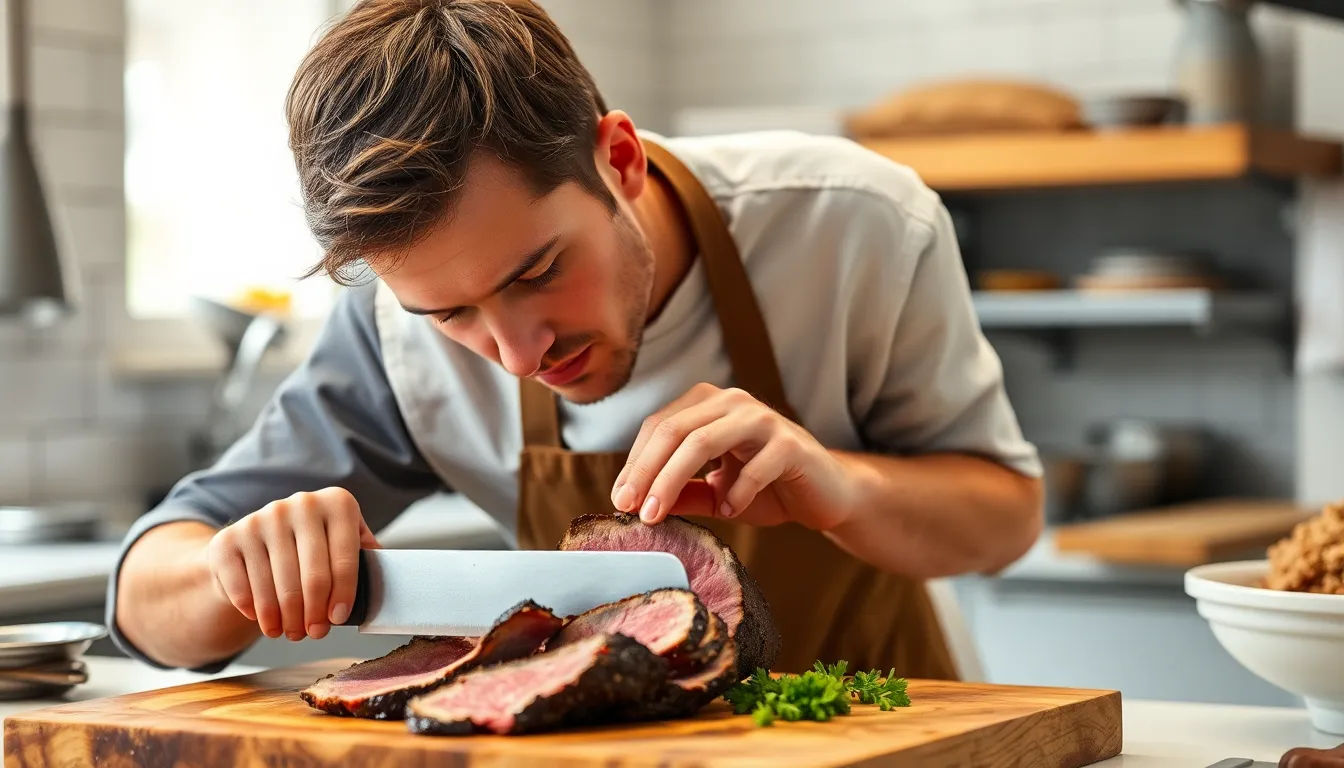
Proper preparation forms the foundation of exceptional air fryer brisket. We’ll walk you through each critical step to ensure your brisket develops maximum flavor and achieves that perfect tender texture.
Trimming the Brisket
We start by trimming our brisket to the optimal fat cap thickness of 1/4 inch. Excess fat prevents our seasoning blend from penetrating the meat properly and interferes with developing that coveted caramelized crust. Using a sharp carving knife, we carefully remove any thick areas of fat while preserving enough to maintain flavor and juiciness during cooking.
The silver skin on the meat side also needs attention. We remove any tough membrane that could create chewy spots in our finished brisket. Our goal is creating an even surface that allows heat to penetrate uniformly throughout the cooking process.
Applying the Dry Rub
We combine all our dry spice ingredients in a mixing bowl to create our signature rub blend. The paprika, brown sugar, kosher salt, black pepper, garlic powder, onion powder, chili powder, cumin, smoked paprika, and cayenne pepper work together to build complex layers of flavor.
Before applying the rub, we lightly coat the entire brisket surface with olive oil. This creates a binding agent that helps our spice mixture adhere properly to the meat. We generously coat all sides of the brisket with our dry rub, then massage it into the meat using our hands. This massage technique ensures the seasonings penetrate deeper into the beef fibers for enhanced flavor development.
Marinating Time
We refrigerate our seasoned brisket for several hours or preferably overnight to allow the rub to penetrate deeper into the meat. This marinating period transforms the surface proteins and creates the foundation for our signature bark formation during cooking.
Before we begin cooking, we remove the brisket from refrigeration and let it rest at room temperature for approximately 30 minutes. This temperature equilibration ensures even cooking throughout the entire piece of meat. Our brisket is now perfectly prepped and ready for the air fryer transformation that will deliver restaurant quality results in record time.
Air Fryer Setup
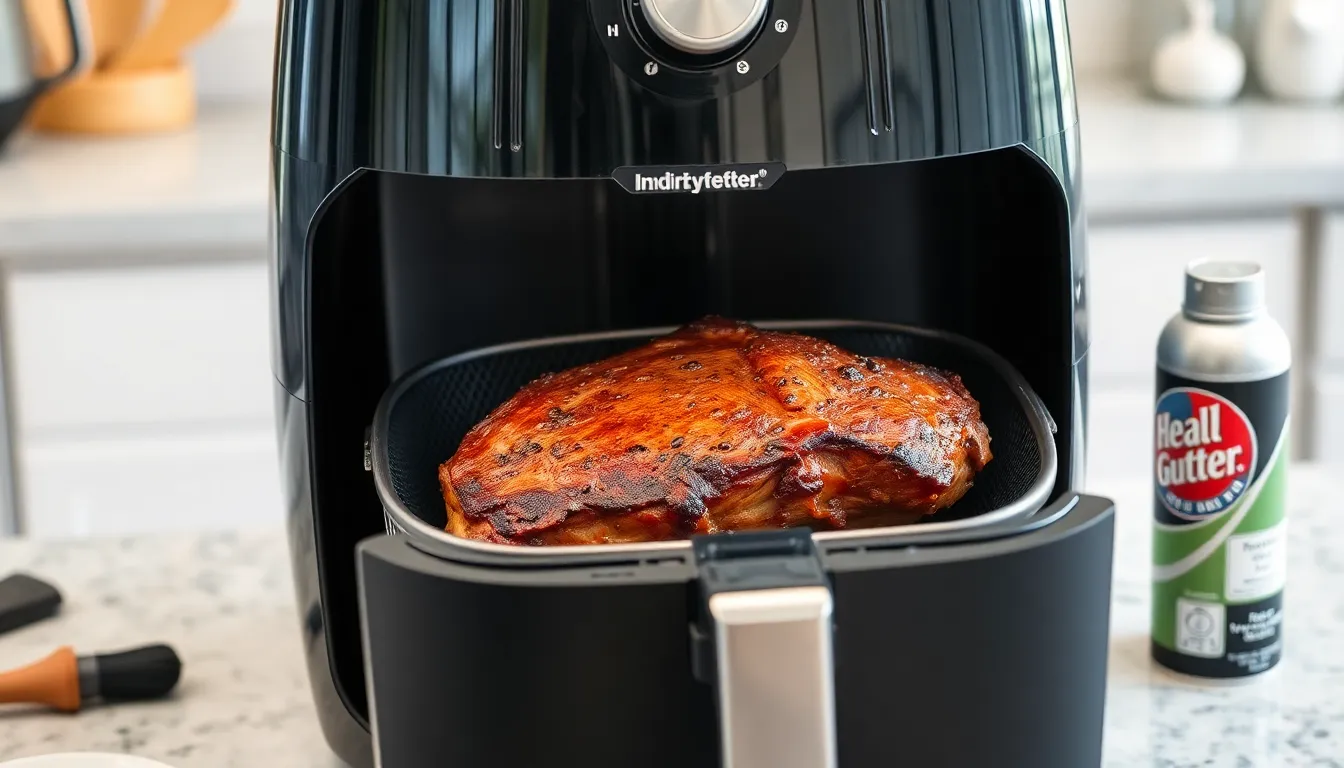
Proper air fryer setup forms the foundation for achieving that perfect brisket texture and flavor. We’ll guide you through the essential temperature and preparation steps that transform your countertop appliance into a brisket-cooking powerhouse.
Temperature Settings
We recommend starting with a preheated temperature of 275°F for the ultimate low and slow cooking experience that delivers fork-tender results. This lower temperature allows the connective tissues to break down gradually over 2 to 3 hours until the internal temperature reaches our target range of 195°F to 205°F.
For those seeking faster results, we can increase the temperature to 375°F and cook for approximately 20 minutes followed by a 10-minute rest period. This method produces a medium-cooked brisket with an internal temperature around 150°F. Some recipes work well at 350°F for about 3 hours with a halfway flip for even cooking.
| Temperature Setting | Cooking Time | Internal Target | Result |
|---|---|---|---|
| 275°F | 2-3 hours | 195-205°F | Fork-tender |
| 350°F | 3 hours | 195°F | Traditional tender |
| 375°F | 20 minutes | 150°F | Medium doneness |
Basket Preparation
We always begin by spraying the air fryer basket lightly with cooking spray or brushing with oil to prevent our precious brisket from sticking. This simple step ensures easy removal and maintains the beautiful crust we’ve worked to create.
Position the brisket in the basket with the fat side facing up or the rounded portion pointing upward. This placement allows the fat to naturally baste the meat during cooking, keeping it moist and flavorful. We ensure adequate space around the brisket for proper air circulation, which is crucial for even cooking and that coveted crispy exterior.
Never overcrowd the basket as this restricts airflow and leads to uneven results. The air fryer’s rapid hot air circulation is what makes this cooking method so effective, so we give our brisket room to breathe and cook evenly on all sides.
Cooking Instructions
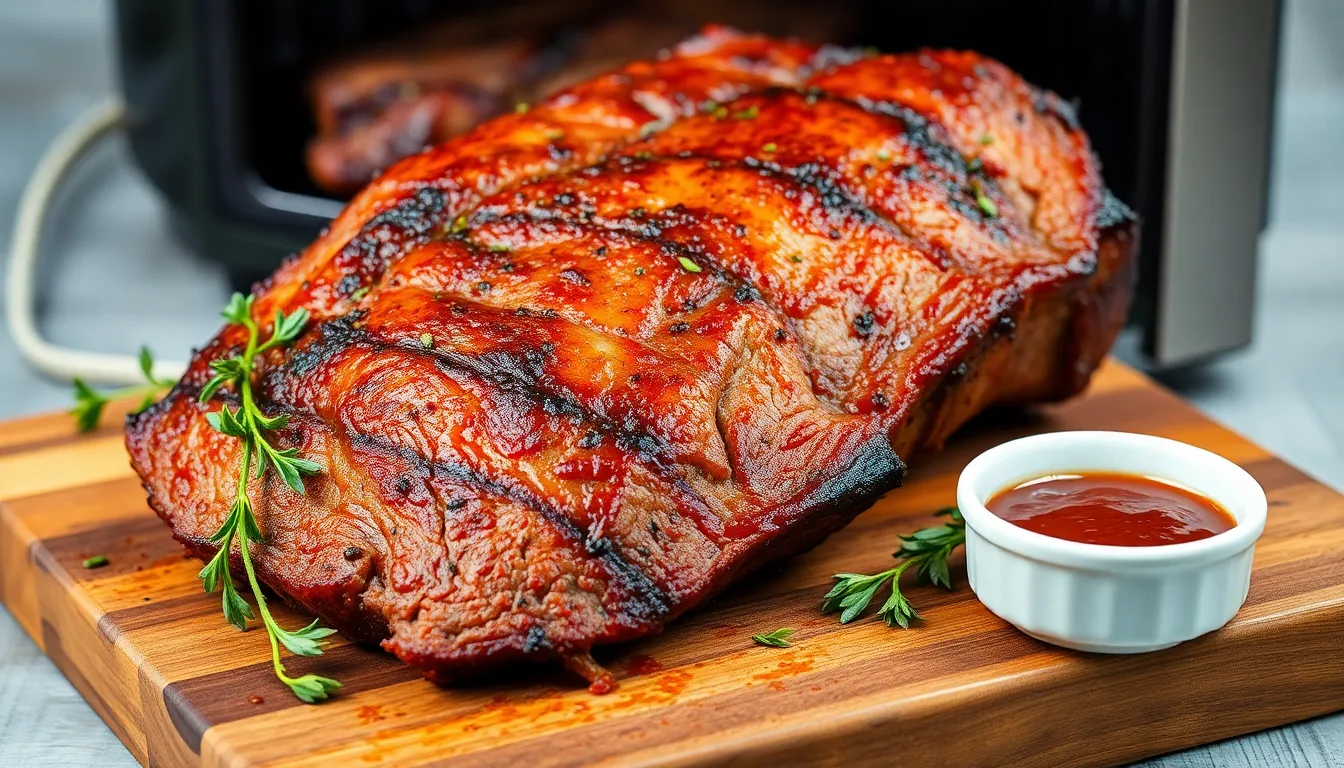
Our air fryer beef brisket recipe follows a precise three-phase cooking method that guarantees tender results every time. We’ve perfected this technique to deliver restaurant-quality brisket with optimal texture and flavor development.
Initial Searing Phase
We begin by preheating our air fryer to 375°F to create the perfect searing environment for our seasoned brisket. The high temperature allows us to develop a beautiful crust while locking in the meat’s natural juices.
Position the brisket fat side up in the air fryer basket after the preheating cycle completes. We place it this way so the rendered fat naturally bastes the meat throughout the cooking process.
Cook for 20 to 30 minutes at this temperature to establish a proper sear on all surfaces. The initial high heat creates that coveted bark while building complex flavors that penetrate deep into the meat.
Main Cooking Phase
After searing we reduce the air fryer temperature to 275°F for the slow cooking phase. This lower temperature breaks down tough connective tissues and transforms them into gelatin for maximum tenderness.
Wrap the brisket tightly in heavy-duty aluminum foil at this stage adding 3/4 cup of beef broth inside the packet. The foil wrapper creates a steam environment that keeps our brisket moist while the lower temperature works its magic.
Continue cooking for 2 to 3 hours depending on your brisket’s size and thickness. We flip the wrapped brisket halfway through this phase to ensure even heat distribution and consistent texture development.
Checking for Doneness
Insert a meat thermometer into the thickest part of the brisket to monitor internal temperature accurately. We rely on precise temperature readings rather than cooking time alone for perfect results.
| Temperature Range | Doneness Level | Texture Result |
|---|---|---|
| 195°F – 205°F | Fully Tender | Fork-tender, easily shredded |
| 185°F – 194°F | Nearly Done | Sliceable but still firm |
| Below 185°F | Underdone | Tough, requires more cooking |
The brisket reaches optimal tenderness when the internal temperature hits 195°F to 205°F throughout the thickest section. At this temperature range the connective tissue has fully broken down creating that signature melt-in-your-mouth texture.
Remove the brisket from the air fryer once it reaches our target temperature and let it rest for 10 minutes before unwrapping. This resting period allows the juices to redistribute ensuring every slice remains incredibly moist and flavorful.
Resting and Slicing

The final steps in our air fryer brisket journey are just as crucial as the cooking process itself. These techniques will transform your perfectly cooked brisket into restaurant-quality slices that showcase maximum tenderness and flavor.
Proper Resting Technique
We allow our brisket to rest for 10 to 30 minutes after removing it from the air fryer. This resting period serves a critical purpose that cannot be skipped or rushed.
During cooking the muscle fibers contract and push juices toward the center of the meat. Resting allows these juices to redistribute evenly throughout the entire brisket. Without proper resting the flavorful juices will spill onto our cutting board instead of staying locked within each slice.
We tent the brisket loosely with aluminum foil during the resting period to maintain warmth while preventing moisture loss. The internal temperature will actually continue to rise slightly during this time completing the cooking process through carryover heat.
Our patience during this phase directly impacts the final texture and juiciness of every bite. Rushing to slice immediately after cooking results in dry tough meat that fails to showcase the time and effort we invested in the cooking process.
Slicing Against the Grain
Before making our first cut we identify the direction of the muscle fibers running through our brisket. These grain lines appear as parallel striations across the surface of the meat.
We position our sharp carving knife perpendicular to these grain lines and slice directly against them. This technique shortens the muscle fibers with each cut making the meat significantly easier to chew and dramatically improving overall tenderness.
Each slice should measure approximately 1/4 to 1/2 inch thick for optimal texture and presentation. Thinner slices may fall apart while thicker cuts become difficult to chew even though proper grain cutting.
We maintain consistent pressure and use smooth confident strokes with our knife to create clean even slices. A sharp blade is essential for this process as dull knives tear the meat fibers instead of cleanly cutting through them.
The combination of proper resting and correct slicing technique transforms our air fryer brisket into tender succulent portions that rival any traditional smokehouse preparation.
Serving Suggestions
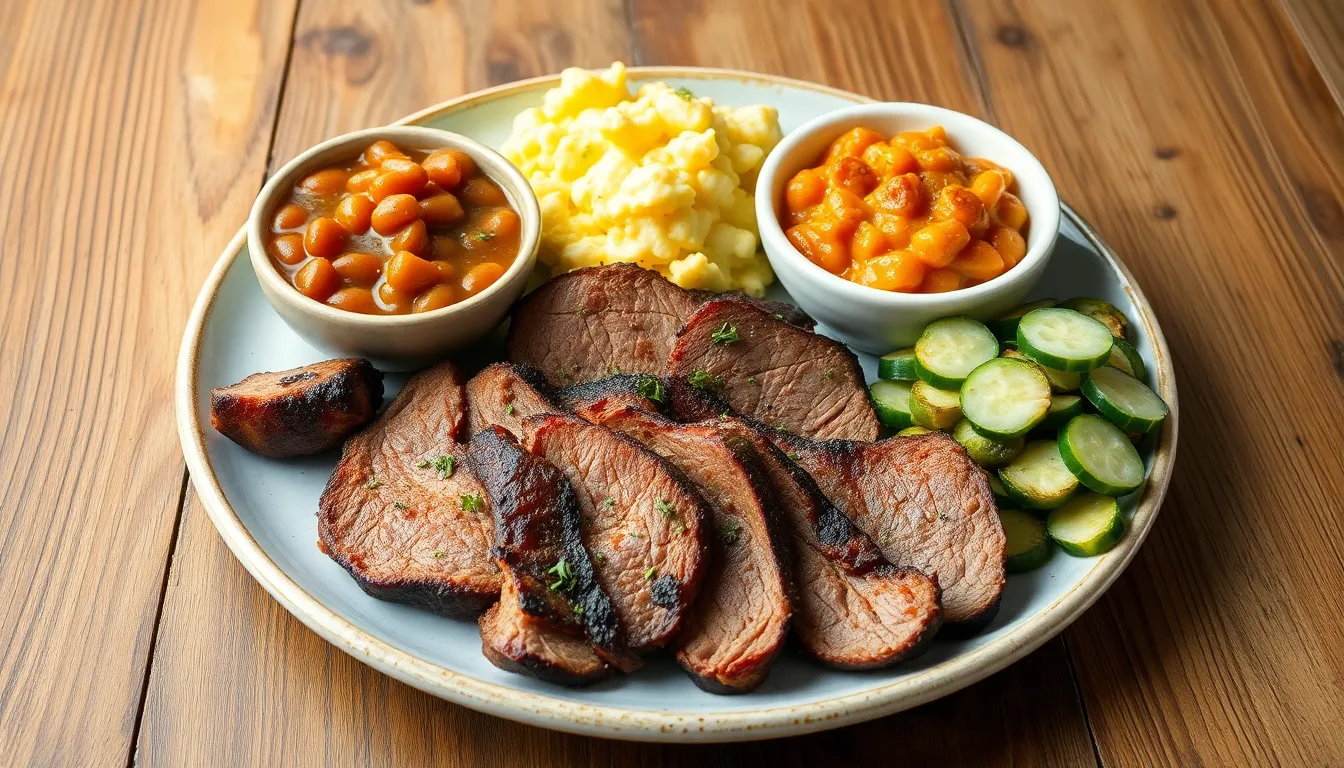
Our perfectly air-fried brisket deserves thoughtful presentation that highlights its tender texture and smoky flavor. We recommend slicing the brisket thinly against the grain and serving it with strategic pairings that complement its rich taste.
Side Dish Pairings
Classic BBQ sides create the perfect foundation for our air fryer brisket experience. We love pairing the tender meat with creamy baked beans that absorb the brisket’s flavorful juices. Mac and cheese provides a comforting contrast with its smooth texture balancing the meat’s robust flavor profile.
Cornbread offers a slightly sweet complement that pairs beautifully with the smoky brisket. Roasted vegetables add nutritional balance and visual appeal to the plate. We particularly enjoy air-fried Brussels sprouts or carrots that develop caramelized edges in the same appliance.
Fresh salads provide a bright counterpoint to the rich brisket. A crisp cucumber salad with vinaigrette cuts through the meat’s richness effectively. Garden salads with light dressings offer refreshing palate cleansers between bites.
Potato dishes round out the meal perfectly. Creamy mashed potatoes create a luxurious base for the sliced brisket. Sweet potato fries add color and natural sweetness that complements the savory meat beautifully.
Sauce Options
Traditional BBQ sauce remains our top choice for improving the brisket’s natural flavors. Sweet varieties amplify the meat’s caramelized crust while smoky options reinforce the air fryer’s concentrated flavors. Spicy BBQ sauces add heat without overwhelming the brisket’s complexity.
Horseradish cream sauce delivers a tangy kick that awakens the palate. This bold pairing works especially well with the brisket’s rich fat content. Mustard-based sauces provide sharp contrast and traditional BBQ authenticity.
Fresh herb sauces bring bright flavors to the plate. Chimichurri adds vibrant green color and herbal notes that complement the meat’s earthiness. These sauces work particularly well for guests who prefer lighter flavor profiles.
Au jus made from beef broth and cooking drippings provides the most natural pairing. We drizzle this savory liquid over sliced brisket to maintain moisture and enhance the meat’s concentrated flavors. This approach lets the brisket’s natural taste shine through without competing sauces.
Storage and Reheating
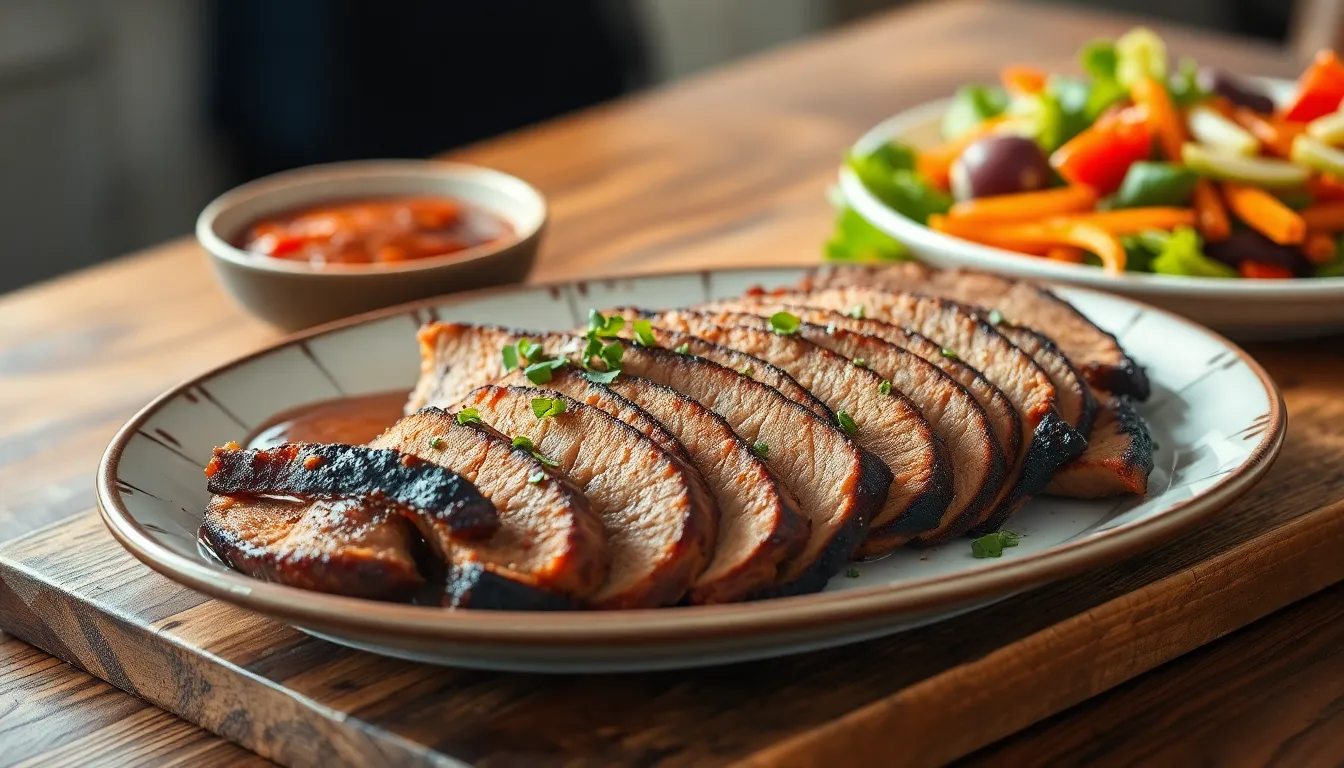
Your perfectly cooked air fryer brisket can be stored and reheated with these simple techniques to maintain its tender texture and rich flavor. We’ll guide you through the best methods to preserve your brisket’s quality for future enjoyment.
Refrigerator Storage
Store your cooked brisket in an airtight container or wrap it tightly in aluminum foil or plastic wrap immediately after it has cooled to room temperature. Refrigerate the brisket promptly to ensure food safety and optimal freshness.
Your air fryer brisket will maintain its best quality when consumed within 3 to 4 days of refrigeration. We recommend labeling the container with the date to track storage time effectively.
Freezer Instructions
Wrap the brisket tightly in heavy-duty aluminum foil or place it in a freezer-safe airtight container to prevent freezer burn. Large freezer bags also work well for protecting the meat during extended storage.
Freeze your cooked brisket for up to 2 to 3 months for optimal quality and flavor retention. We suggest slicing the brisket before freezing to allow for easy reheating of individual portions when needed.
Reheating Methods
Air Fryer Method: Preheat your air fryer to 300°F and wrap the brisket in foil before placing it in the basket. Reheat for 10 to 15 minutes until the internal temperature reaches your desired warmth.
Oven Method: Preheat your oven to 300°F and place the brisket in foil with a small amount of broth or water to maintain moisture. Heat for 20 to 30 minutes until thoroughly warmed.
Microwave Method: Place brisket slices on a microwave-safe dish and cover with a damp paper towel to prevent drying. Use medium power and heat in 1-minute intervals until warmed through to avoid overheating.
Allow the brisket to rest for a few minutes after reheating to let the juices redistribute throughout the meat. This resting period ensures your reheated brisket maintains its original tenderness and flavor profile.
Tips for Success
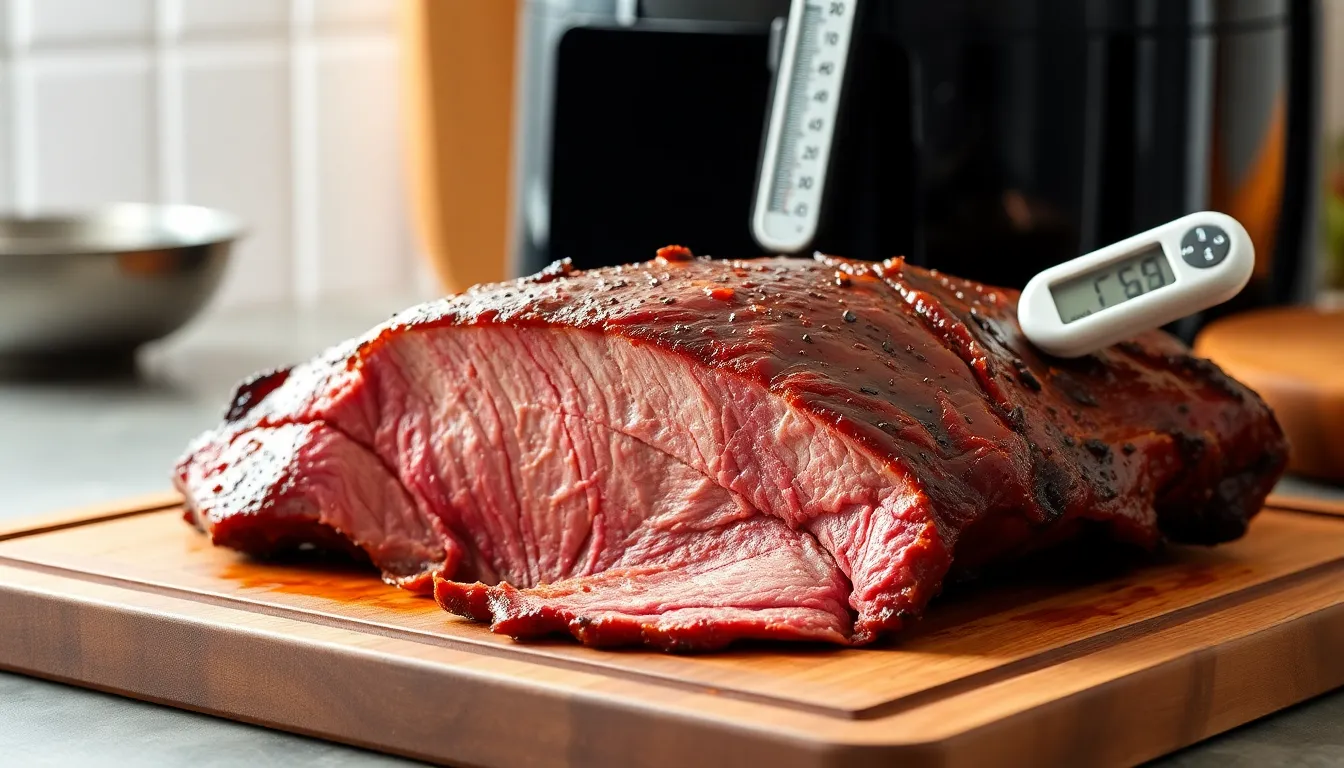
Mastering air fryer brisket requires understanding a few key principles that separate good results from exceptional ones. We’ve identified the most critical factors that will elevate your brisket from ordinary to extraordinary.
Choosing the Right Cut
We recommend selecting a beef brisket flat that weighs between 3 to 4 pounds for optimal air fryer results. The cut should maintain a fat cap on one side, which serves as natural basting during the cooking process to keep the meat moist and flavorful.
Smaller briskets ranging from 1.5 to 2.75 pounds work well for quicker cooking methods, while larger cuts require the low and slow approach to properly break down the tough connective tissue. We always ensure our brisket has been properly trimmed to a 1/4 inch fat cap, removing excess fat and silver skin for even cooking.
The quality of your brisket directly impacts the final result. We look for cuts with good marbling throughout the meat and avoid pieces that appear dry or have been sitting in the display case too long.
Temperature Monitoring
Accurate temperature monitoring serves as the foundation for perfectly cooked brisket every time. We use a reliable meat thermometer or select an air fryer equipped with a built-in meat probe for consistent results.
Internal temperature targets vary based on your desired outcome and cooking method:
| Cooking Method | Target Internal Temperature | Result |
|---|---|---|
| Quick Cook (smaller cuts) | 150°F (65°C) | Medium doneness |
| Slow Cook (larger cuts) | 195°F-205°F (90°C-96°C) | Fork-tender, pull-apart texture |
We insert the thermometer into the thickest part of the brisket for the most accurate reading. The probe should avoid touching fat or bone, which can give false temperature readings.
Monitoring temperature throughout the cooking process allows us to make adjustments as needed. We check the internal temperature every 30 minutes during the slow cooking phase to ensure steady progress toward our target.
Troubleshooting Common Issues
Tough brisket typically indicates undercooking, especially when dealing with larger cuts. We increase cooking time and aim for higher internal temperatures of 195°F or above to properly break down the collagen into gelatin.
Dry brisket results from cooking without the protective fat cap or removing it too early in the process. We always position the brisket fat side up, allowing the rendering fat to continuously baste the meat during cooking.
Uneven cooking occurs when we overcrowd the air fryer basket or fail to flip the brisket midway through cooking. We ensure adequate space around the brisket for proper air circulation and flip it once during the cooking process for even bark formation.
Lack of smoky flavor can disappoint those expecting traditional barbecue taste. We address this by adding liquid smoke to our dry rub or seasoning blend, which enhances the flavor profile in the air fryer environment.
Temperature fluctuations sometimes cause inconsistent results. We preheat the air fryer thoroughly and avoid opening the basket unnecessarily, which can cause heat loss and extend cooking times.
Conclusion
We’ve shown you how to transform your air fryer into a powerful tool for creating exceptional beef brisket that rivals traditional smoking methods. This technique delivers tender juicy results in a fraction of the time while maintaining that coveted smoky flavor and caramelized crust.
The beauty of this method lies in its simplicity and reliability. With proper preparation temperature control and our tested techniques you’ll consistently achieve restaurant-quality brisket that’s perfect for any occasion.
Your air fryer brisket adventure starts now. Follow our detailed guide and you’ll be amazed at how this versatile appliance can elevate your home cooking game while saving precious time in the kitchen.
Frequently Asked Questions
How long does it take to cook beef brisket in an air fryer?
The cooking time depends on your preferred method. For tender, fork-tender results, cook at 275°F for 2-3 hours after an initial 20-30 minute sear at 375°F. For quicker results, cook at 375°F for about 20 minutes for medium doneness. Total cooking time ranges from 20 minutes to 3.5 hours depending on your preference.
What internal temperature should air fryer brisket reach?
For maximum tenderness and that perfect “fall-apart” texture, aim for an internal temperature of 195°F to 205°F. For medium doneness with quicker cooking, target around 150°F. Always use a reliable meat thermometer to ensure accuracy and food safety.
Do I need to wrap the brisket in foil while air frying?
Yes, wrapping in foil is recommended during the main cooking phase at 275°F. Wrap the brisket with a small amount of beef broth to create a moist cooking environment. This technique helps retain moisture and ensures tender results, similar to traditional smoking methods.
How do I prevent my air fryer brisket from drying out?
To prevent drying, maintain a 1/4 inch fat cap when trimming, cook fat-side up, and wrap in foil with beef broth during the low-temperature phase. Avoid overcooking by monitoring internal temperature carefully, and always let the brisket rest for 10-30 minutes after cooking to redistribute juices.
Can I make the dry rub ahead of time?
Absolutely! You can prepare the dry rub in advance and store it in an airtight container. For best results, apply the rub to your brisket and refrigerate for several hours or overnight. This allows the flavors to penetrate the meat deeply, resulting in more flavorful brisket.
What size brisket works best in an air fryer?
A 3-4 pound beef brisket flat is ideal for most standard air fryers. This size ensures proper air circulation around the meat while fitting comfortably in the basket. For larger briskets, consider using an air fryer toaster oven or cutting the brisket into smaller portions.
How should I slice air fryer brisket?
Always slice against the grain for maximum tenderness. Cut slices 1/4 to 1/2 inch thick using a sharp carving knife. Let the brisket rest for 10-30 minutes before slicing to prevent juices from running out and ensure each slice remains moist and flavorful.
How long can I store leftover air fryer brisket?
Store leftover brisket in an airtight container in the refrigerator for 3-4 days. For longer storage, freeze sliced brisket for up to 2-3 months. This makes reheating easier and helps maintain quality. Always slice before freezing for convenient portion control.
What’s the best way to reheat air fryer brisket?
Reheat in the air fryer at 275°F for 3-5 minutes, in a 300°F oven wrapped in foil for 10-15 minutes, or in the microwave with a damp paper towel for 30-60 seconds. Add a splash of beef broth if needed to restore moisture.
Why doesn’t my air fryer brisket taste smoky enough?
The smoked paprika in the dry rub provides the primary smoky flavor. For more smokiness, increase the smoked paprika, add liquid smoke to your spritz mixture, or include it in your optional sauce. You can also try wood chips designed for air fryers if your model supports them.

